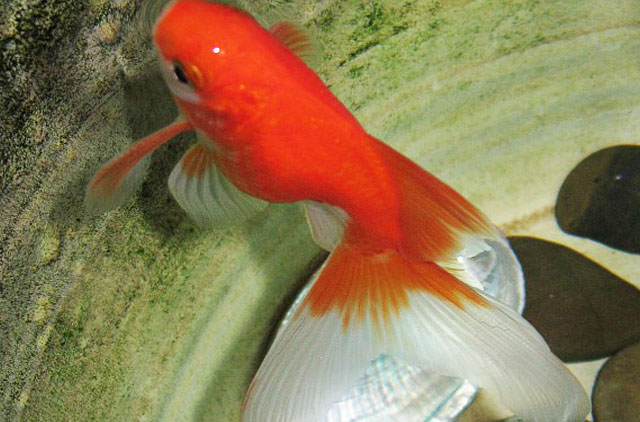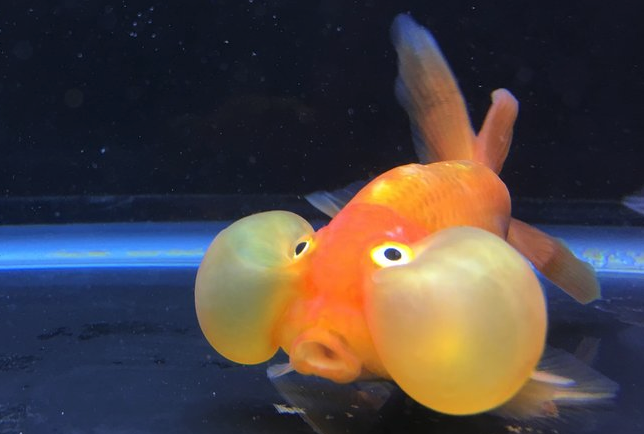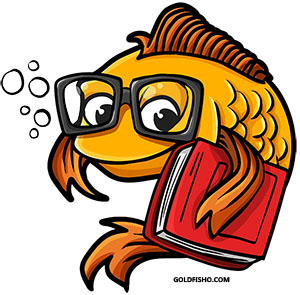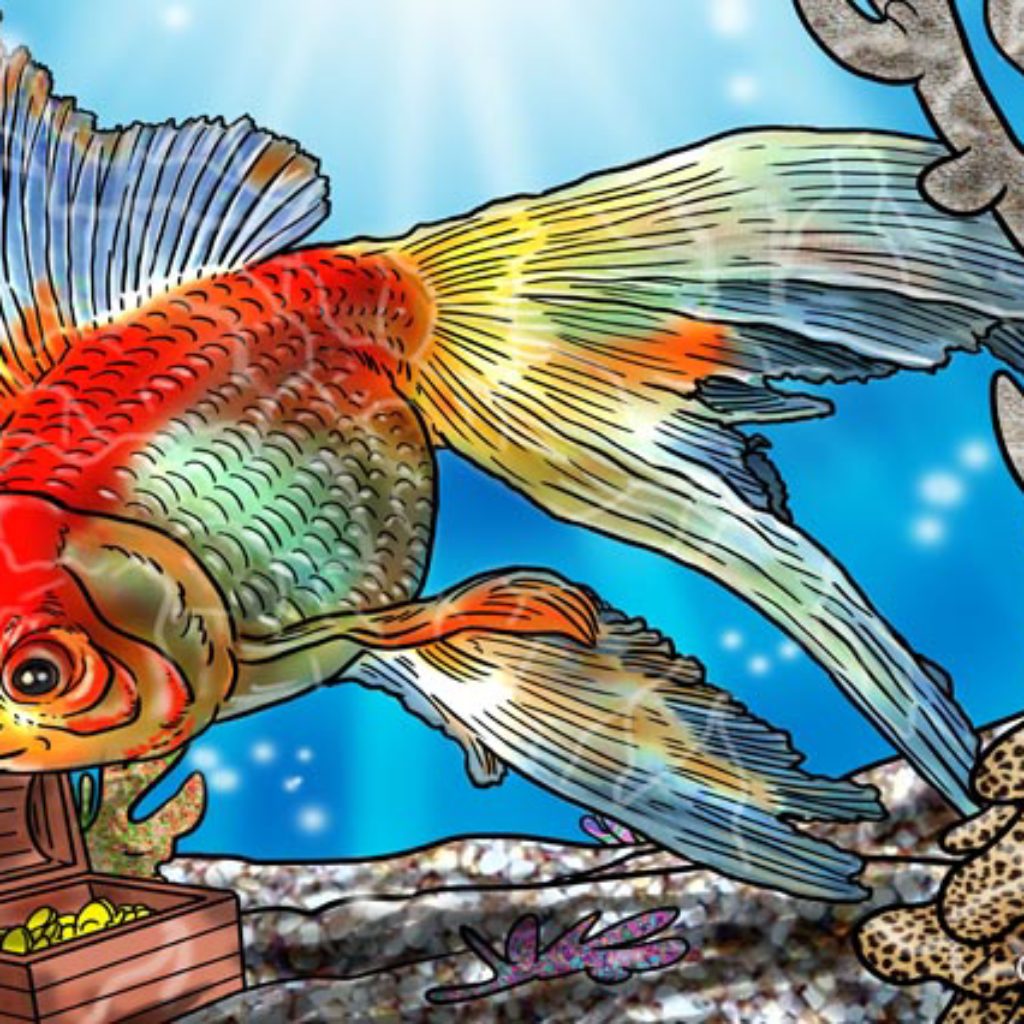Goldfish are incredible creatures that are far more complex than people realize.
There are over 125 varieties of goldfish in the world.
One of these magnificent creatures is known as The Fantail Goldfish.

They are beautiful and graceful beings that are capable of reducing your stress without saying a word.
Let’s dive into the tank and learn more about the glorious Fantail Fancy Goldfish.
The History of the Fantail Goldfish:
Many years ago, the Chinese began to breed Carp that was often found in their water sources. They were relatively easy to catch as they were fond of calm rivers, ponds, and lakes.
The breeding process was started with the intention of mass producing already captive fish in order to feed a lot of people much more quickly and easily.
During the mass breeding process, some of the Carp were born with a yellowish-orange hue instead of the silvery Carp color.
The Chinese became fascinated by this new hue and would separate these Carp from the others.
They would then only allow the colored Carp to mate with other colored Carp. Thus, the Goldfish was born!
All species of goldfish are derived from the Carp. This explains why many of them closely resemble them.
However, there are some goldfish, known as Fancy Goldfish that hardly resemble the Carp at all.

The original fancy goldfish first appeared in the 1400’s in China during the Ming Dynasty.
They had chubby, egg-shaped bodies, and split tail fins. This original fancy goldfish is known as the Fantail Fancy Goldfish.
Although many species of goldfish have the split caudal fins and are technically “fantailed” they are not necessarily a Fantail Fancy Goldfish.
Fantail Fancy Goldfish are considered to be their own goldfish species and are recognized as such during goldfish shows.
Physical Traits of the Fantail Goldfish:
In order for a Fantail Fancy Goldfish to be entered into a show, they need to meet certain show standards. Otherwise, the judges will not deem the fish as a worthy specimen of the species.
The show standards for the Fantail Fancy Goldfish includes body shape and size, caudal fin specifics as well as their scales and coloration.
The body of the Fantail Goldfish should be rounded, chubby, and similar to the shape of an egg. The shorter the body is in length (compared to the overall depth) the better the show specimen is considered. However, the judges will accept a body depth of 3/5 or more of the body’s length.
The caudal fin specifics of the Fantail Fancy Goldfish are of particular importance to the show judges.
They should be set high and stable (not drooping heavily). The split should be obviously divided and forked.
When viewed from the side, the upper lobe of the caudal fin should be longer than the lower lobe. There should be a single, high dorsal fin that remains upright.
The Fantail Fancy Goldfish can develop as any number of colors and patterns. They can be a variety of solid colors including red, orange, and yellow. They can also be various patterns including calico.
The color or pattern of the Fantail Fancy Goldfish is not as important to the show judges as the multiple other factors.
However, solid fin colors are, and ideal physical trait to the goldfish show judges.
Difficulty of care of the Fantail Goldfish:
The Fantail Fancy Goldfish can be an excellent choice for first-time fish owners.
They can be relatively easy to care for as long as you understand the basic requirements of goldfish and you implement them.
They are not a fragile type of fancy goldfish (delicate fancy goldfish include the Bubble Eyed Fancy Goldfish, Telescope Eyed Fancy Goldfish, etc.) meaning that they will not be easily affected by the filtration or décor inside the aquarium.

The Fantail Goldfish is a competent swimmer even though he is not fast nor slow.
As a result of his swimming abilities, he should be placed in an aquarium or outdoor pond with fish that are similarly competent.
In other words, he should not be tankmates with the Comet Goldfish or other very agile swimmers nor should he be placed with extremely slow swimmers such as the Bubble Eyed Fancy Goldfish or Lionhead Fancy Goldfish.
If you are considering starting a goldfish aquarium or an outdoor pond with goldfish inside of it, then you should make sure that you are providing a healthy environment for them.
For example, goldfish require filtration regardless of the habitat.
The filtration ensures that the water they are living in is safe for them and free of harmful bacteria.
If you plan to use tap water to fill the tank or pond, then you will need to purchase a water conditioner.
The water conditioner clears the tap water of harmful heavy metals and chlorine (which are toxic to fish).
You should never overpopulate your goldfish environment.
The rule of thumb to follow for a safely populated goldfish aquarium or outdoor pond is to plan at least 20 gallons of water per fish.
For example, if you want five goldfish in the habitat then you should prepare to purchase a 100-gallon aquarium.
This may seem excessive.
However, the fish do not stay small for very long, and they require room to grow, swim and plenty of oxygenated water for them to breathe.
30% of the tank water should be replaced every two weeks. The new water should be treated with water conditioner before being added to the tank.
Filter parts or décor that need to be cleaned should be in the tank water that had been removed.
Rinsing or cleaning them in untreated tap water may cause your fish to go into shock when the object is returned.
Also, you may rinse away the beneficial bacteria.
Gravel and fish should never need to be removed from the aquarium during a cleaning.
Gravel can be cleaned by using a gravel vacuum.
Nutrition and Feeding the Fantail Fancy Goldfish:
You may think feeding goldfish is a piece of cake. You may believe that goldfish only eat Goldfish Flakes or Goldfish Pellets. However, this is not the whole truth!
Yes, goldfish can be fed these products, and they are readily available at any local pet store.
However, goldfish actually enjoy a variety of different types of food.
They are omnivores so they will happily consume plant sources as well as meat sources.
Now, don’t think that you can offer your goldfish a pound of ground beef and that they would be happy to eat it.
The truth is, their meat sources are a little different. Goldfish, like the Fantail, enjoy:
- Insects
- Worms
- Mosquito larvae
- Bloodworms
- Brine shrimp
- Flies
- Ants
They will happily accept any one of these meat sources as a protein filled meal. On the other hand, goldfish also enjoy plant source meals such as:
- Plants (usually they will nibble on the live plants you place inside the tank)
- Plant roots (goldfish are diggers, and they may uproot a live plant to nibble on the roots)
- Leaves
- Vegetables including broccoli, mashed peas, and lettuce
- Fruits including blueberries and strawberries (cut up)
- Algae (they will usually nibble on the algae growing inside the tank)
When choosing what to feed your goldfish, you should consider mixing and matching the above items with their regular goldfish food.
For example, you may want to feed your Fantail Fancy Goldfish some goldfish flakes as their first meal, a few worms as their second meal and finally some leaves or lettuce as their third meal.
Goldfish should be fed two to three times per day. Generally, they should be fed morning, afternoon and evening. However, this will depend on your schedule as well.

Goldfish flakes and pellets are good choices for a quick meal (usually provided during your busiest time of day).
Regardless of what you are feeding your goldfish, or when you are feeding them, you should never overfeed them.
Goldfish are instinctual munchers. This suggests that they will eat just about anything at any time, and they can quickly become overweight if you allow this.
Therefore, you should only provide your Fantail Goldfish with the amount of food that they can consume in two to three minutes time. Uneaten food will only sink to the bottom of the aquarium, become moldy and pollute the water.
Habitat Requirements of the Fantail Fancy Goldfish:
A Fantail Fancy Goldfish can grow quite large if provided the space to do so. They should be kept in a rectangular shaped habitat.
Rectangular aquariums or outdoor ponds offer your fish adequate surface area for swimming, growing as well as quality oxygenated water for breathing.
The Fantail Goldfish is a hardy fish and therefore it should not be easily damaged by the filtration device, décor, or other objects inside the tank.
They require a filtration system that offers mechanical, biological and chemical filtration.
These three systems will ensure that floating debris and other things inside the water are removed.
As previously mentioned, goldfish require a habitat that is not overpopulated with other inhabitants.
Each goldfish should have about 20-gallons of water.
Therefore, if you have five Fantail Fancy Goldfish, then they should be living in a 100-gallon tank.
This rule of thumb is set to provide adequate living conditions for the inhabitants without them swimming into each other.

Another problem that could occur if a tank is overpopulated is excessive pollution. More residents result in more waste.
The more waste that is in the water (that they use to breathe) the less oxygen is available.
Personality and Temperament of the Fantail Goldfish:
The Fantail Goldfish is a very interactive fish. They have been known to anticipate their owner’s arrival and enjoy their company.
They are not typically a fish that easily spooks nor are they usually shy.
In fact, the Fantail is very enjoyable, friendly, docile, and more interested in making friends with their tankmates than enemies.
They are not known to start fights with other fish.
However, there are always exceptions to the rule.
They may become aggressive if a threat presents itself.
Potential Health Problems of the Fantail Goldfish:
Goldfish can be prone to a variety of health problems, especially if they are not adequately cared for. These health conditions include but are not limited to:

1. Goldfish ICH: Ichtyopthirius Multifiliis is a parasitic condition that creates a marked effect on the goldfish’s scales. This disease is also known as White Spot Disease after the spots that appear suddenly.
2. Swim Bladder Disease: a common balance disorder amongst fish. This can be the result of various other health problems including constipation, parasites, or poor nutrition.
3. Fin Rot/ Tail Rot: this is a symptom of an underlying condition. This is a sign that shows as an apparent “rotting away” of your goldfish’s fins or tail. Causes of this symptom include bacteria, parasites, fighting with other fish, and stress.
4. Fungal Infections
5. Anchor Worm: A highly contagious crustacean common amongst Koi fish and Goldfish. These crustaceans cause your fish to demonstrate body rubbing as well as experience inflammation and respiratory problems.
6. Fish Lice: Also crustaceans that are common in outdoor pond inhabitants. The fish will exhibit body rubbing, loss of color, as well as loss of appetite. These crustaceans can inject the fish with viruses and bacteria which could cause further health problems.
7. Ulcers and Tumors
Temperament: CommunityFamily: CyprinidaeNative To: China and JapanDiet: Omnivore: can be fed commercial pellets and fish flakesAdult Size: 6″ or moreTemperature: prefer water in the range of 65 – 78FCare Level: Easy for a noviceScientific Name: Carassius auratusExpected Lifespan 10 years or moreEnvironment: Freshwater
Fantail Goldfish Questions and Answers

What is a Fantail goldfish?
- Type: fancy
- Colors: orange, silver, black, bronze, red, red/white
- Type of Swimmer: slow
- Temperament: peaceful
- Single or Twin-tail: twin
- Level of Care: great for beginners
What does a Fantail goldfish cost?
$3 – $12 each
Are Fantail Goldfish Good For Beginners?
Yes
What are compatible tank mates for Fantail goldfish?
Other slow swimmers; Black Moor, Ranchu, Lionhead, Bubble Eye, Ryukin
Note: Slow swimming goldfish should not be placed with fast swimming goldfish. Fast swimmers are aggressive eaters at feedings.
Characteristics and Traits of Fantail Goldfish
How large does a Fantail goldfish get?
6” – 12”
What is the lifespan of Fantail goldfish?
10-15 years
Diet of Fantail Goldfish
What does a Fantail goldfish eat?
- Pellets
- Live food (bloodworms, shrimp)
- Fruits & vegetables
- Flake food
Tank Requirements for Fantail Goldfish
What size tank does a Fantail goldfish need?
- Minimum: 20-30 gallons
- Fish-to-tank Ratio is 1” of fish per 1 gallon of water
What should the water temperature be for a Fantail goldfish; and do I need to have a heater for the tank?
- 65 – 78 degrees (F)
- A heater is required to maintain water temperature.
Do I need to have an air stone (air pump) in my Fantail goldfish’s tank?
Yes but be careful not to have an overly powerful one because of the Fantail’s slow swimming nature which the water movement caused by a large airstone may hinder.
Does a Fantail goldfish’s tank require a filtration system?
- Yes, all goldfish should have a filtration system in their tank.
- Be careful that your filtration system’s water intake is not too powerful for the Fantail because they are slow swimmers and too much movement in the water can be difficult for your Fantail to tolerate.
Final Thoughts to sum up:
Fantail Fancy Goldfish can be incredible family pets. If they are properly cared for and kept in good health, then they should have no problem living for decades and growing rather large in size.
They may be prone to health problems but, close observation, as well as quality water, should keep the health conditions minimal and easy to treat.
Always purchase your Fantail Fancy Goldfish from a reputable pet store or breeder. If purchasing them online be sure to use a reputable seller.
Finally, Fantail Fancy Goldfish are a fantastic choice for those who suffer from stress on a daily basis as their pure presence can relieve you.



I just got my first fantail. Can I submit pics to you guys so you can post it on your site?
Hi Melissa,
Feel free to send it to linda@goldfisho.com